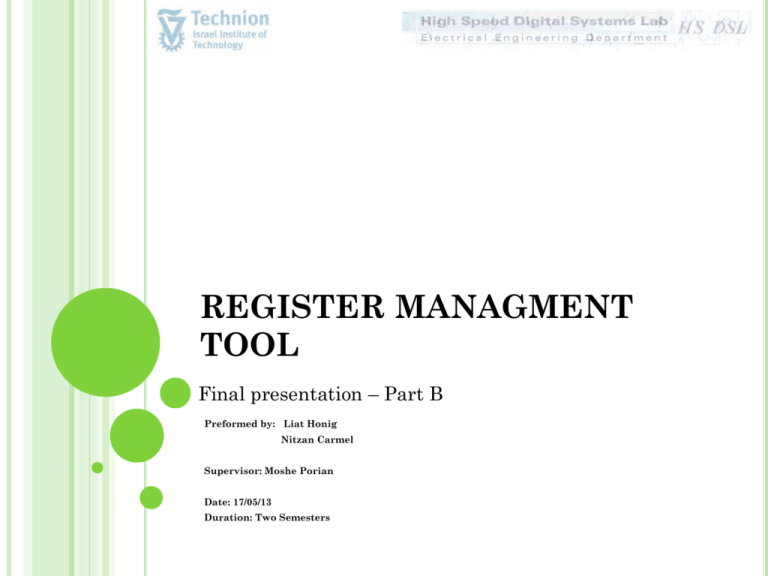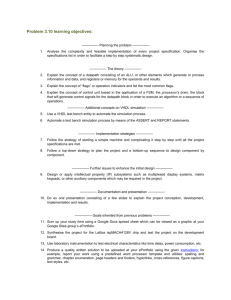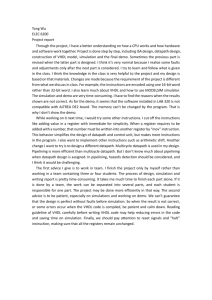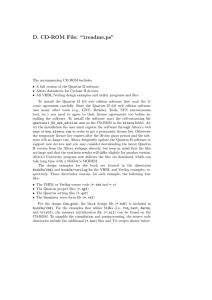Final Presentation
advertisement

REGISTER MANAGMENT TOOL Final presentation – Part B Preformed by: Liat Honig Nitzan Carmel Supervisor: Moshe Porian Date: 17/05/13 Duration: Two Semesters MANY TEAMS NEED TO CREATE THEIR OWN REGISTER BLOCKS FOR FPGA SYSTEMS. LEADING TO BUGS Double Effort THE SOLUTION A REGISTER MANAGEMENT TOOL Automatically generates registers according to a required specification using a smart interface! AUTOREG – A SMART REGISTER MANAGEMENT TOOL INSERT YOUR PROJECT’S SPECIFICATIONS TO THE GUI AUTOMATICALLY CREATE VHD AND HSID FOR REGISTER BLOCKS! THE SOLUTION – A REGISTER MANAGEMENT Project Goals TOOL Automatically registers according to the o Determinegenerates and characterize a local bus forrequired specification. communication with all the register slave blocks. Enables REUSE o Generic Implementation that allows reuse in multiple projects. Saves money and resources o Encapsulation of implementation, which will be hidden from the user. Creates unity in the registers VHD files THE SOLUTION – A REGISTER MANAGEMENT Project Goals TOOL o Determine and characterize a local bus for Creates documentation the register components communication with for all the slavecreated blocks. Leads to an organized – HSID o Generic Implementation that allows reuse in multiple projects. Alarms in case of incorrect input o Encapsulation of implementation, which will be hiddenthe from the user. Manages registers through the entire project Project Goals o Determine and characterize a local bus for communication with all the register slave blocks. o Generic Implementation that allows reuse in multiple projects. o Encapsulation of implementation, which will be hidden from the user. PROJECT SPECIFICATIONS 1. Writing a GUI interface through which the user will determine a variety of attributes. 2. Interactivity - The tool will provide feedback for user errors and will provide a summary output. 3. VHDL: VHD files Local Bus Master Simulation Environment 4. No special license will be needed to operate the tool, an EXE file will be given to the user. 5. HSID will be generated under IEEE standards (IP-XACT) PROJECT STEPS 1. Determine the implementation platform of the user interface and data processing: Excel/MATLAB/C++/C#/JAVA . 2. Full characterization of the tool capabilities. 3. Learning the working environment (Wishbone protocol, advanced VHDL coding , MODELSIM simulation environment). 4. VHDL generic design and simulation. 5. Implementing the GUI (Graphic User Interface) 6. Implementing Automatic VHDL generation. 7. Final MODELSIM and MATLAB Simulations. VHDL IMPLEMENTATION GENERAL DESCRIPTION Project Goals Local Bus Register access o Determine and characterize a local bus for communication with all the register slave blocks. Register Register Block Block Chip o Generic data I/O Register Block Implementation that allows reuse in multiple projects. o Encapsulation of implementation, which will be hidden from the user. VHDL TOP ARCHITECTURE reset clk ProjectBlock Goals A Reg_status_1 Wishbone Master Function_1 o Determine and characterize a local bus for communication with all the register slave blocks. o Generic ImplementationReg_enable_2 that allows reuse in Function_2 Block_A_reg_top multiple projects. o Encapsulation of implementation, which will be hidden from the user. func_err_3 Function_3 REG BLOCK ARCHITECTURE Block_A_reg_top Inputs from block o Determine and characterize a local bus for Reg1 communication with all the register slave blocks. Outputs to block Reg2 Reg3 Priority Encoder WB Master o Generic Implementation that allows reuse in WB multiple Slaveprojects. 4 o Encapsulation of implementation, which will be reg_chosen hidden from the user. Reg4 Data from chosen register Functional Block GENERIC IMPLEMENTATION GENERIC IMPLEMENTATION VHDL SIMULATION SIMULATION ENVIRONMENT Macro Scripts SIMULATION ENVIRONMENT Macro Scripts • Compilation • Simulation • Waveforms Test Bench SIMULATION ENVIRONMENT Results Output File Simulation input Macro Scripts • Compilation • Simulation • Waveforms Simulation outputs Test Bench • Procedure called serially many times • Comparison to expected values • Reporting results to output file Waveforms TEST PLAN - OVERVIEW Testing small modules separately gen_reg.vhd: Read Write Read/Write Clear On Read Const. wbs_reg.vhd Read transactions (single/burst) Write transactions (single/burst) encoder_generic.vhd Then, testing the entire design Gen_block.vhd TEST PLAN – CASES Testing Regular Activity Various generic values for address width Various values for data Read/Write single/burst wishbone cycles for suitable registers Testing system boundaries Testing system generics SYNTHESIS SYNTHESIS RESULTS A synthesis demonstration was ran, using Quartus II 12.0sp2, using the following test case: 32 registers, with 8-bit data width, with device EP4CGX50DF27C6 Compilation and Synthesis finished successfully. Summaries: Maximum Frequencies: • Slow 1.2V 85C model – 1199MHz • Slow 1.2V 0C model – 1328MHz NETLISTS GRAPHICAL USER INTERFACE REQUIREMENTS FROM GUI Easy to use user experience Feedback is provided in real time Data is filled automatically if possible Easy project view and management Data and Address can be represented in both Hexadecimal and Decimal formats OPENING SCREEN – PROJECT SETTINGS Settings made for the entire project Choose a protocol Specify address width Choose address radix Specify data width Choose data radix Specify number of blocks Specify a directory to save the generated files Browser for finding the requested directory OPENING SCREEN – PROJECT SETTINGS Settings made for the entire project Choose a protocol Specify address width Choose address radix Specify data width Choose data radix Specify number of blocks Specify a directory to save the generated files Continue to next screen 2ND SCREEN – EDIT BLOCK SETTINGS Opens text editor Settings made for the specific block Specify a name Provide a description (optional) 2ND SCREEN – EDIT BLOCK SETTINGS Settings made for the specific block Specify a name Provide a description (optional) Specify an initial address Specify number of registers choose reset polarity Navigation tree view back to project settings delete current block Continue to next screen 3RD SCREEN – EDIT REGISTER SETTINGS Settings made for a specific register Specify a name Provide a description Choose register type Specify the offset address Specify the initial data value Navigation tree view Back to block settings delete current register 3RD SCREEN – EDIT REGISTER SETTINGS Settings made for a specific register Specify a name Provide a description Choose register type Specify the offset address Specify the initial data value TOP MENUS File menu Create a new project Open an existing project Save project as Save current project Close current project Exit AutoReg Help menu About AutoReg Open user guide Generate menu Report for errors Generate VHDL files TREE VIEW “Top View” of the entire project Automatically sorted by the absolute address Allows easy navigation between all the screens and components Addresses and names are filled automatically Navigation is blocked when errors or missing data is found in the current window ERRORS DISPLAY AutoReg notifies the user and prevents access to some contents in the project whenever: Data isn’t legal/valid/ complete Addresses/bits are overlapping Easy to use user experience Feedback is provided in real time Before Deleting an object OUTPUTS ERROR REPORT HSID XML – ACCORDING TO IP-XACT STANDARD VHD FILES VHD files and reports are created in two subfolders: DEMO SUGGESTIONS FOR A LATER PROJECT 1. An option to create a wide register (more than one address). 2. Support other protocols (not wishbone only) 3. Support more register types 4. Add a possibility to mix between the bits of the same register when it comes to access manners. 5. Support boards and not just on FPGA 6. Search and filter possibilities 7. Copy-Paste possibilities SUGGESTIONS FOR A LATER PROJECT 8. Creating a database with options to import and export 9. An option to duplicate , add or delete a register using a right-click option from the tree view. 10. Unifying the edit_block figure and the edit_reg figure to prevent window from “jumping” 11. Under the help menu, add a keyboard map for all keyboard shortcuts of the GUI. Link: AutoReg Gui - other features.docx THE END





